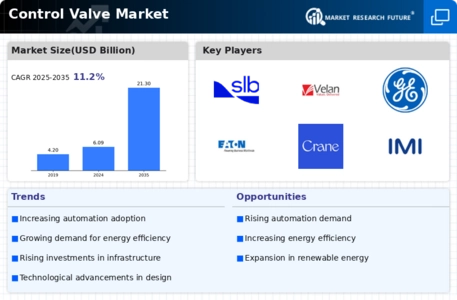Q2 2024: Emerson Launches New Fisher FIELDVUE DVC7K Digital Valve Controller Emerson announced the release of its Fisher FIELDVUE DVC7K digital valve controller, designed to improve reliability and performance in process control applications. The new product features advanced diagnostics and connectivity for industrial automation.
Q2 2024: Flowserve Expands Manufacturing Facility in Chennai, India Flowserve inaugurated an expanded manufacturing facility in Chennai to increase production capacity for control valves and related flow control products, aiming to meet growing demand in the Asia-Pacific region.
Q2 2024: Rotork Appoints New CEO, Kiet Huynh Rotork announced the appointment of Kiet Huynh as Chief Executive Officer, effective May 2024, to lead the company’s global flow control and automation business, including its control valve segment.
Q3 2024: Metso Launches Neles NDX 2.0 Intelligent Valve Controller Metso introduced the Neles NDX 2.0, an intelligent valve controller designed for improved process efficiency and digital integration in control valve applications across multiple industries.
Q3 2024: Baker Hughes Wins Major LNG Project Valve Contract in Qatar Baker Hughes secured a significant contract to supply control valves and flow control solutions for a major LNG expansion project in Qatar, supporting the country’s energy infrastructure growth.
Q3 2024: SAMSON Opens New Digital Innovation Center in Frankfurt SAMSON AG opened a new Digital Innovation Center in Frankfurt, Germany, focused on developing smart control valve technologies and digital process automation solutions.
Q4 2024: Emerson Acquires Afag Holding AG to Expand Automation Portfolio Emerson completed the acquisition of Afag Holding AG, a provider of automation and control solutions, to strengthen its position in the global control valve and industrial automation markets.
Q4 2024: Siemens Launches New Modular Control Valve Platform for Process Industries Siemens introduced a modular control valve platform designed for flexible integration and enhanced performance in process industries, targeting applications in chemicals, oil & gas, and water treatment.
Q1 2025: IMI plc Announces Strategic Partnership with Honeywell for Smart Valve Solutions IMI plc entered into a strategic partnership with Honeywell to co-develop smart control valve solutions, leveraging digital technologies for predictive maintenance and process optimization.
Q1 2025: Schneider Electric Unveils EcoStruxure Control Valve Analytics Platform Schneider Electric launched the EcoStruxure Control Valve Analytics platform, a cloud-based solution for real-time monitoring and predictive diagnostics of industrial control valves.
Q2 2025: Valmet Wins Major Pulp Mill Control Valve Supply Contract in Brazil Valmet secured a contract to supply control valves and automation systems for a new pulp mill project in Brazil, supporting the country’s growing forestry and paper industry.
Q2 2025: Pentair Opens New Valve Manufacturing Facility in Texas Pentair inaugurated a new manufacturing facility in Texas dedicated to the production of industrial control valves, aiming to enhance supply chain resilience and serve North American customers more efficiently.

















Leave a Comment